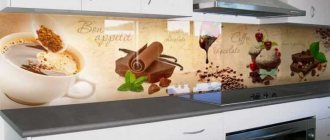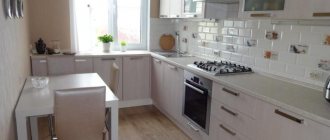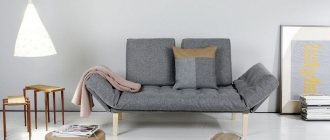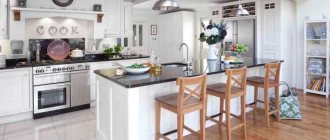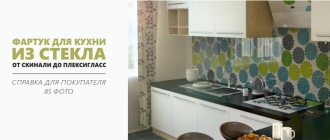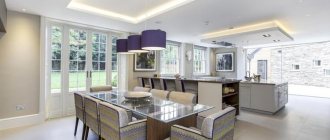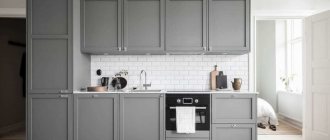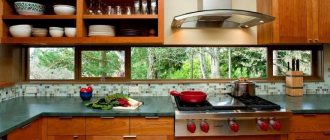Help the site, share with friends:
The kitchen is a special room in any apartment, since it is subjected to quite serious loads every day.
It is for this reason that the chosen finishing materials for its surfaces must not only be beautiful, but also necessarily practical and capable of withstanding various types of contamination.
For example, you can choose a kitchen apron made of plastic, which has a huge number of advantages.
This material has an affordable price and can be installed quite simply without carrying out any additional major repair work.
One of the most important advantages of this material is that it is resistant to temperature changes and is able to protect against any type of contamination, such as water, grease or simply condensation.
ABS
This type of plastic is produced in granules, from which panels 300 x 60 cm and 1.5 mm thick are then formed. An apron made of this material can withstand temperatures of 80°C indefinitely. Resistant to bending and impact loads.
Often panels made from this polymer are coated with a metallized coating that successfully imitates metal, but the light weight of the products allows them to be delivered and installed at a lower cost compared to mirror glass panels.
Device functions
Initially, the screen occupied the space only above the stove. But in reality, grease, dirt, steam, and dyes get on walls and tables not only during frying, but also when cutting vegetables, washing food, mixing in open containers and other culinary processes. As a result, screens in the kitchen began to occupy all the space above the work tables, sink and stove.
Not all materials are suitable for making devices. They must meet the following requirements:
- resistance to temperatures - the air above the stove, especially a gas stove, gets very hot. Only heat-resistant materials are suitable for finishing this area. The screen around the induction cooker can also be made of MDF, although this is not the best option;
- resistance to moisture – the kitchen work area is characterized by high humidity. Materials that cannot withstand cold and hot steam, inevitable condensation and the action of salts are completely unsuitable for cladding. With good hood, this requirement becomes less strict;
- hygiene - porous materials, among other things, retain moisture, and therefore create an excellent environment for the proliferation of bacteria and fungi. A kitchen safety screen should prevent such a danger. The apron is made from materials with minimal porosity: metal, tile, glass;
- mechanical strength – glass screens made of ordinary material are quite easily damaged by an accidental blow. A more durable or more elastic option is preferable: plastic, plexiglass, metal;
- cost – applies to both material and design. A glass screen with photo printing for a kitchen made of MDF will cost half the entire set. A polycarbonate sheet with a decorative film looks no worse, but costs much less.
Positive qualities of ABS
The advantages of this plastic include:
- Resistance to chemically active substances.
- No reaction with substances contained in food products.
- Possibility of producing surfaces with any color and light reflectance.
- No harm to health.
- Wide operating temperature range - from -40°C to +90°C.
How much does it cost and where to buy
You can purchase plastic panels for the apron in an online store or large construction hypermarkets. Currently, almost any retailer offers a wide range of similar products.
Before purchasing, you should carefully read the documentation and ask the seller for safety certificates. The fact is that low-quality plastic produced in artisanal conditions can release chemicals hazardous to health into the air.
The average cost of plastic for an apron is:
PVC - from RUB 160.00/sq.m.
ABS - from RUB 800.00/sq.m.
Acrylic glass (polycarbonate) - from RUB 5,000.00 / sq. m.
The final price is influenced by the type of source material, thickness, individual design and method of applying the design.
Types of PVC panels
Manufacturers supply panels and sheets in the following sizes:
- 300 x (15-50) cm;
- (80-203) x (150-405) x (0.1-30) cm;
- lining 300 x (10-12) cm.
PVC does not require preparation of the wall surface, and is so easy to install that it does not require professional training from installers. Often, the owners of the premises install the PVC apron themselves.
Materials for protective screens
Various options are used for a kitchen apron. Many models can be made and installed yourself, for example, a screen made of tiles or plastic. When installing more complex or expensive ones, such as those with photo printing, for example, you will need the help of specialists.
- Tile is the most affordable and very decorative material. You can make an apron with your own hands, using a variety of styling options and color combinations.
- MDF is an option only permissible when using electric or induction cookers, as well as with good exhaust hood. However, in practice this applies to laminated material or MDF with PVC trim. Plates with an acrylic glossy coating can withstand very high temperature changes and are completely insensitive to moisture.
- Chipboard - has the same disadvantages as MDF - the material is flammable, but also less resistant to moisture and steam. This is a budget cladding option, but, alas, it is very short-lived. Moreover, it loses its decorative effect even faster, since its top finishing layer easily peels off under the influence of moisture and temperature changes.
- A glass kitchen screen is an expensive and very high-quality option. Impact-resistant glass is used for the kitchen wall. It is very difficult to damage it, it is very easy to wash it from any type of contamination, the hygiene of the material is maximum. The decorative effect of glass screens is enormous: panels can be painted, tinted, matte, sandblasted, or photo printed.
A significant disadvantage of glass products is their high weight and fragility, even with high strength. It is unrealistic to install the skins yourself. In addition, it is necessary to take into account the weight of the glass screen: not every wall will support such a significant mass.
However, the most popular material remains different types of plastic. Slightly inferior in quality to the listed options, it also has a very affordable price.
Negative aspects of a polyvinyl chloride apron
- Reduced abrasion resistance.
- Loss of strength over time.
- Loss of color and attractive appearance from sunlight and chemicals.
- Potential for mold to develop in the cracks between panels.
- High risk of fire from contact with open flame.
- Possibility of releasing toxic substances into the atmosphere.
The release of harmful substances occurs only in low-quality products, so before purchasing you should check whether the product has a quality certificate.
Note!
- Linoleum for the kitchen - master classes on installing linoleum in the kitchen interior. The best design ideas and color schemes (120 photos)
- Illumination of the work area in the kitchen: TOP-130 design options. Rules for selecting and installing lighting in photo reviews
- Stretch ceiling in the kitchen - TOP-130 design options for stretch ceiling in the kitchen + photo examples
Design ideas
In order for such a finish to look stylish and not cheapen the interior, it is better to pay attention to options with natural wood finishes: wood, marble, stone, brick. A light sheet with marble “veins” looks especially relevant. The main thing is to choose textures and images that are as close to natural as possible. In one version, imitation wood can look very natural, but in another it can look completely unnatural. The colors should not be too bright, and the top layer should not be glossy. Matte surfaces look better because glare and reflections will give off unnaturalness. As for texture, there are options for panels with a rough finish. In this design, the imitation of rocks looks quite natural.
Instagram @schmidt_officiel
Instagram @rkply01
ShutterStock
You should also give preference to monochromatic options or simple geometry, imitation tiles, bricks. It is better to choose sheets that cover the entire length of the working surface, so that there are no unnecessary joints (it is simply impossible to glue sheets so that the seams are not visible, but it looks ugly, besides, moisture will get into the joints, and the coating will quickly become unusable) . For this reason, it is worth abandoning PVC tiles, which are glued to the wall like ordinary ceramic ones.
Instagram @tepian.living
Instagram @riko.ua
Instagram @demiliodesign
Instagram @_magnoliahome
Polycarbonate cladding can be used in different ways, by gluing it on top of wallpaper, a painted wall, or masonry made of natural stone or wood. The glossy glass finish looks good in minimalist and modern kitchens.
ShutterStock
ShutterStock
Instagram @rkply01
- Kitchen
How to decorate the walls in the kitchen: 11 materials and examples of their use
Color solutions
The specificity of polymer production is such that during the production process the product can be given any color: from delicate and translucent shades to bright ones. The choice of colors depends on the design of the kitchen and its size. Light shades visually expand the space, while dark shades reduce it.
The kitchen apron is located in the work area and often gets dirty. Therefore, choosing black and white colors is not advisable, since dirt is most noticeable on such surfaces. A more suitable option for a kitchen apron may be a soft pastel shade.
Care
Despite the unpretentiousness of plastic aprons, it is necessary to ensure proper care for them:
- Regularly clean the surface from dirt using a damp sponge. Particular attention is paid to grease stains, which are well absorbed by many polymers, and after drying they are extremely difficult to remove.
- Do not use highly aggressive products, such as acetone. Dish cleaning products are best.
- It must be remembered that abrasive substances can damage the surface of the plastic. The resulting scratches will be especially noticeable on a glossy surface.
- The fire of the stove burners can cause the plastic to ignite or heat it to an unacceptable temperature, where there is a risk of harmful emissions. It is advisable to use special thermal screens in the slab area.
- For most plastics, direct sunlight is harmful. The pattern and color quickly fade. Care should be taken to avoid such influences.
- Special care requirements are provided in the instructions for use of the materials. If they are not included with the product, then you need to analyze the features of the plastic according to information on the Internet.
Plastic aprons have gained wide popularity in modern kitchen interiors. This is facilitated by their high quality, unpretentiousness, ease of installation and great design possibilities. Such elements effectively compete with ceramic tiles, glass and other expensive coatings.
Photos of plastic aprons
Plastic screens in the kitchen
Plastic is an incredibly diverse material. It can imitate any natural material and even artificial and almost any type of finish. At the same time, plastic is hygienic, quite durable, and insensitive to moisture and steam. Its only drawback is sensitivity to high temperatures. However, this factor also differs for different materials.
- The easiest way to make a kitchen screen is to use PVC panels. You can install both plastic sheet panels and lining. The material can imitate stone, wood, brickwork, mosaic. PVC lining is moisture resistant and easy to clean. If necessary, repairs are very simple: any damaged fragment is removed and a new one is installed in its place.
The disadvantage of this option is its poor resistance to high temperatures: already at +80 C° the material begins to deform. Accordingly, it is not suitable for installation near a gas stove.
- Acrylic glass – polymethyl methacrylate. This material can be transparent or colored and replace glass. Moreover, it was so successful that it was called plexiglass. It is impossible to break it: the material has excellent viscosity and simply absorbs energy from impact. It is insensitive to most acids and alkalis, that is, it can be washed using household chemicals, and it can be removed even from the harshest dyes.
Acrylic glass is lightweight, so making a protective screen is not difficult. In addition to the fact that the material can be colored, it can also be decorated in another way: paste wallpaper of any kind on the wall and cover it with a piece of glass.
The disadvantage is that the temperature resistance is rather low for a kitchen: at +80° C, the plastic begins to deform. It is better not to install it near a gas stove; you can make an acrylic screen near an electric or induction stove.
- Polycarbonate glass - only monolith is used for finishing in the kitchen. This material is a little more expensive, but its properties are superior to acrylic plastic. With the same excellent water resistance, polycarbonate tolerates temperatures up to +120° C, so it can be installed near a gas stove. Such a screen is even easier to make than an acrylic one, as it tolerates any type of processing very well. Polycarbonate is extremely durable and cannot be damaged by a direct blow from a hammer.
Polycarbonate can be transparent. Moreover, its degree of transparency is higher than that of acrylic; it can be matte and tinted. In addition, the material can serve as protection for other, less resistant finishes - such as PVC film, wallpaper or photo wallpaper.
The disadvantage is that the resistance to temperatures is not so high - a protective kitchen screen made of polycarbonate will not withstand direct exposure to flame. In addition, with high strength, plastic is quite easy to scratch.
How to attach a plastic screen
Installation of plastic panels of various types is carried out using 2 main technologies.
- Frame - plastic sheets are fixed to a pre-assembled frame. For prosaic plastic screens, this is the only acceptable installation method.
- Using glue - this method is allowed if the wall surface is perfectly flat. Installation is carried out by analogy with laying tiles. Disadvantage: repair in this case is more difficult, since the fragment is fixed directly to the wall.
The sequence of actions is as follows.
- Wooden or metal slats are attached along the perimeter of the future apron. The position of the slats is checked using a plumb line and level.
- The bottom rail is fixed at the level of the worktop or lower, but not less than 5 cm from the floor. The top one is installed at the level of the bottom edge of the wall cabinets.
- If necessary, a third horizontal bar is placed between them. The latter is required only if the distance between the top and bottom is more than 50 cm.
- The frame is lined with acrylic or polycarbonate. Self-tapping screws or construction staples are used to secure the plastic.
- When installing transparent plastic that imitates glass, it is recommended to use slats with grooves to install sheets in them.
The disadvantage of this method is the appearance of space between the plastic and the wall. To prevent mold or mildew from appearing here, it is necessary to thoroughly treat the kitchen wall with antiseptics.
A plastic screen is a good alternative to a glass or even tiled apron, as it is highly durable, resistant to moisture and steam, and is very decorative. However, only polycarbonate material is resistant to temperatures, so when installing an apron near a gas stove, this option is preferable.

